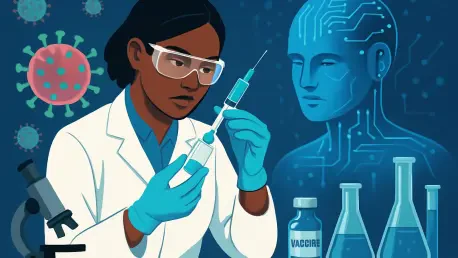Could a machine hold the key to ending one of humanity’s most persistent health crises? At Scripps Research, a staggering $1.1 million investment in artificial intelligence (AI) is igniting a new chapter in the fight against HIV, a virus that continues to impact over 40 million people worldwide. This cutting-edge initiative isn’t just about faster computers—it’s about reimagining how science tackles a pathogen that has eluded a vaccine for decades. Picture a lab where millions of potential solutions are tested in mere hours, not years, bringing the dream of protection closer than ever before.
Why This Matters in the Global Health Landscape
The stakes couldn’t be higher. HIV remains a leading cause of death globally, with its rapid mutation rate making it a moving target for researchers. Despite advances in treatment, the absence of an effective vaccine leaves millions vulnerable, perpetuating cycles of illness and loss. The effort at Scripps, backed by the Scripps Consortium for HIV/AIDS Vaccine Development (CHAVD) and the National Institutes of Health, targets this gap head-on, using AI to address a challenge that traditional methods have struggled to overcome. This isn’t just a scientific endeavor—it’s a critical step toward global health equity.
The urgency is palpable. With new infections still occurring at alarming rates, the need for a preventive solution has never been more pressing. Scripps’ approach, blending technology with immunology, offers a beacon of hope, potentially transforming how the world responds to not only HIV but other elusive diseases as well.
Breaking Barriers with AI-Powered Innovation
At the heart of this project lies a technological leap: high-performance computing systems that double processing power and operate four to five times faster than existing tools. These advancements allow the Scripps team to analyze millions of vaccine designs—a scale unimaginable with older, manual processes that could only handle a few dozen at a time. This speed is crucial in identifying candidates that might trigger broadly neutralizing antibodies, proteins capable of targeting over 90% of HIV strains in most individuals.
Beyond raw speed, AI introduces precision to the process. Real-time feedback from clinical trials enables researchers to adjust vaccine designs on the fly, focusing efforts on the most promising paths. Led by Associate Professor Bryan Briney and Professor Andrew Ward, the team is also exploring adaptive vaccine series that evolve with HIV’s mutations, aiming for the ultimate goal of a single, long-lasting dose. This dynamic approach marks a departure from static, trial-and-error methods that have long hindered progress.
Voices from the Frontline of Discovery
The optimism at Scripps is grounded in expertise and early wins. Bryan Briney calls AI a tool to “supercharge” scientific discovery, breaking through data bottlenecks that once took years to navigate. His perspective highlights how technology can compress timelines, turning mountains of information into actionable insights with unprecedented efficiency. This shift means less time guessing and more time testing viable solutions in the lab.
Professor Andrew Ward adds another layer, emphasizing the power of computational screening. “Instead of experimenting blindly, hundreds of thousands of possibilities are vetted before lab work begins,” he notes. A striking example of this potential emerged when AI identified a neutralizing antibody among 2,000 candidates from an uninfected individual—a rare find suggesting that natural immune strengths could inform future vaccine strategies. Such discoveries underscore AI’s ability to spot needles in haystacks that human analysis might overlook.
The collaborative spirit at Scripps amplifies these efforts. By uniting multiple labs with CHAVD, the project pools diverse expertise, ensuring that every angle of the problem is tackled. This synergy not only accelerates progress but also builds a framework that other research teams might replicate, amplifying the impact far beyond a single institution.
A Blueprint for Tackling Complex Diseases
The implications of this work extend well into practical realms, offering lessons for the broader scientific community. Investing in computational infrastructure, as Scripps has done, stands out as a priority—high-speed systems are no longer optional but essential for managing the vast data from modern trials. This upgrade ensures that researchers can keep pace with the complexity of diseases like HIV.
Equally important is fostering partnerships. The alliance between Scripps and external consortia demonstrates how shared knowledge can drive innovation faster than isolated efforts. Moreover, the AI-driven techniques being refined here, such as predictive modeling, hold promise for other mutable viruses like influenza or malaria, suggesting a scalable model for future health challenges. Focusing on broadly neutralizing antibodies also ensures that solutions are versatile, protecting diverse populations against evolving threats.
Reflecting on a Milestone in HIV Research
Looking back, the $1.1 million investment at Scripps Research marked a turning point, blending AI with human ingenuity to confront HIV in ways previously unimagined. The strides made in analyzing vast datasets and uncovering rare immune responses offered a glimpse of what was possible when technology and science aligned. Each discovery, from accelerated designs to unexpected antibodies, built momentum in a field that had long faced setbacks.
As the journey continued, the path forward became clear: sustained funding for computational tools was vital to maintain this pace. Expanding collaborative networks would further amplify impact, ensuring that breakthroughs reached those most in need. Above all, applying these methods to other global health threats promised a ripple effect, potentially safeguarding millions. The work at Scripps laid a foundation—now, the challenge rested in scaling these innovations to transform lives worldwide.









